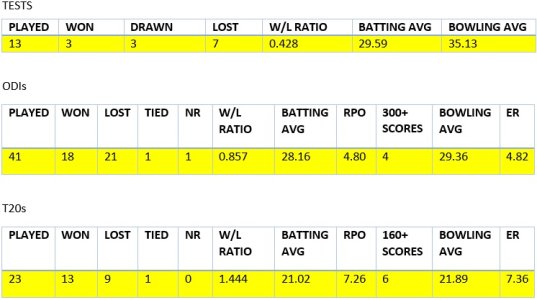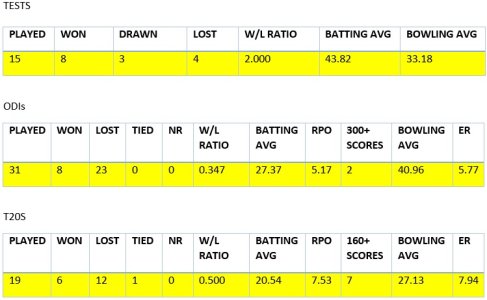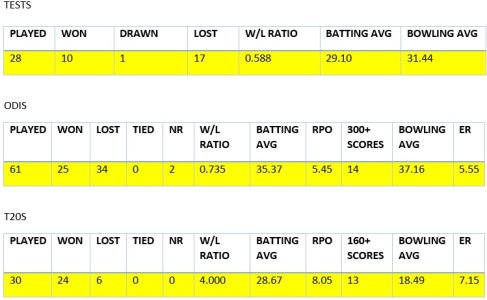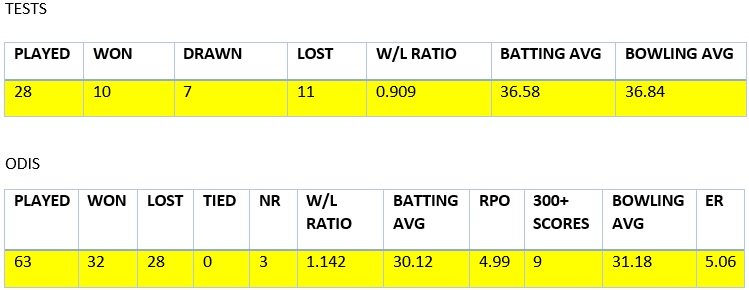England, and the Importance of Faith and Strategies.
(Long post. TLDR: Strategies are important. England abandoned theirs in the 2015 World Cup, but have stuck with a new one since. Also remember to back your players, which England did now but didn’t at the last World Cup.)
Cricket is a team sport. That’s why you can’t just be content with picking your best players, they need to have synergy, complement each others’ strengths, and cover their weaknesses. To succeed, you need to play to a strategy. This does sound a bit like football or T20 league talk, but it’s true. Having the best players won’t always be enough, to go the extra mile, you need a plan to win. A quick example is Australia, who are overloaded with top order batsmen. David Warner, Aaron Finch, Usman Khawaja, and Shaun Marsh are all openers. Alex Carey would also open for South Australia. Steve Smith is a number 3 batsman. Carey has batted this whole tournament at 5, 6, or 7, while at least 4 of the rest have played in every game except the semi final. At least one of them is always out of position, and coming out to bat at a time that doesn’t suit their batting style. The talent is there, but the synergy and planning isn’t.
Before the 2015 World Cup, England had a plan. Their plan might have been outdated, but it was at least something. The idea was to have one opener take advantage of the first powerplay’s fielding restrictions and be aggressive, while the other opener and the batsmen at 3, 4, and even 5 accumulated runs throughout the innings. Then at the end, maybe the last 5 to 10 overs, the batsmen would up the tempo. Hopefully they’d end up with 250. On a good day, even 300. Their bowlers would bowl test match lines with the new balls, maybe getting some early wickets. After that it was about stemming the flow of runs. It may be an outdated plan, one that wouldn’t work on flat pitches, as they had an upper limit on their score and their bowlers were one dimensional and helpless without assistance from the pitch, but it was something. It would work on pitches which assisted pace bowling, as England usually went with 4 pacers and one spinner, and batted without much risk. England had shown their willingness to play to this plan. Once they found an opener who could play in that “aggressive” role, they decided that one of Cook or Bell was surplus. So they dropped the more out of form Cook on the eve of the Cup. Not ideal, but they were sticking to their guns. There was a tri series with Australia and India that preceded that World Cup. And England didn’t do too badly in it. They beat India twice, both times on pitches with some life in it, and ran Australia close enough twice. While they got thrashed in the final, they had done well enough before to be optimistic enough for the World Cup. Sure, they weren’t going to win, but they would do alright. Surely a quarter final spot at least. Maybe even a semi final spot too if things go extremely well. Moeen Ali was the aggressor up top. Ian Bell, James Taylor, and Joe Root would accumulate in the middle. Eoin Morgan, Ravi Bopara, Jos Buttler, and Chris Woakes would make quick runs at the end. James Anderson, Stuart Broad, Steven Finn, and Woakes could bowl what was required of them. Moeen and Root would sneak in 10 overs in the middle while being cheap. They had picked a side that could play to their strategy. But then, when they played the first game of that World Cup, they didn’t enter with that 11. Crucially, they played Gary Ballance instead of Ravi Bopara, and had Ballance bat at 3 while Taylor got shunted to 6. Taylor wasn’t built for that “final flourish” role, while Ballance wasn’t part of the planning beforehand. He was in the side as a backup to one of the accumulators. Now he was playing with all of them in the same 11. The balance (get it?) of the side was upset. At the last possible second, England had betrayed their plan.
Now, keeping the 11 that had finished second in the tri series wouldn’t have won England that World Cup. They still may not have made the quarter finals with it. But at least they would’ve shown faith in themselves. They abandoned their thinking at, quite literally, the last moment, and played that World Cup, one which broke new batting ground, as a muddled mess. It was so bad that they hit the reset button on their ODI cricket after it. New plan, and this time they would stick with it.
Morgan, Andrew Strauss, and Paul Farbrace got together to discuss what they’d do next. What approach should they take by the time the next World Cup rolled around on home soil? The approach they picked was much like the one Brendon McCullum and Mike Hesson’s New Zealand used in that World Cup: score quick runs throughout the innings, and keep taking wickets. So they adjusted the squad to play to this plan. There are a ton of players playing senior cricket in England. Finding people to fill the roles the thinktank created wasn’t hard. Gone was Ian Bell, too slow for the role of scoring quickly up front. In came Jason Roy and Alex Hales, largely of T20 fame. Joe Root and James Taylor wouldn’t play in the same 11. They both had the same role, and one of them batting at 4 would only be of use if 2 wickets fell quickly at the start of the innings. England had faith in their top 3 to last a while, so having another accumulator at 4 was unnecessary. Root would start, and Taylor was his backup. Morgan would now be at 4, a more attacking option in the middle but able to play the long haul if needed. The hard hitting Ben Stokes was recalled and played at 5. He also added with the ball (more on that later). Then, more quick scorers, with Buttler at 6, and Sam Billings at 7, followed by the bowling line up of Adil Rashid, Chris Jordan, Liam Plunkett, and Finn. That was a batting line up that would look to attack throughout, and would always keep the runs flowing. The bowlers were less one dimensional than the ones that had played in the World Cup. Rashid was an attacking option that spun the ball both ways, Plunkett had variations, while Stokes and Finn could bowl quick. They would always be looking for wickets, even if they went for runs doing so. The batting lineup allowed them to not worry about being expensive, as the batsmen would cover it. The bowlers just needed to take wickets. England chose this strategy to follow, now they just needed to show some faith and stick with it.
England have not only stuck with this mode of playing, but also the players. The side that will play the World Cup final is very similar to the one that played New Zealand at Edgbaston 4 years ago to kickstart the new era. Roy, Root, Morgan, Stokes, Buttler, Rashid, and Plunkett are still here. Hales has been changed out for Bairstow, for both on field and off field reasons. There’s Chris Woakes in place of Sam Billings, so England now have the luxury of a sixth bowler (7 if you count Root) in case one of the bowlers has a bad day. And there is Jofra Archer and Mark Wood in place of Chris Jordan and Steven Finn. Both bowlers add extreme pace, and each has their own way of attacking the batsmen with it. Even the squad of 15 is close to the one that played that New Zealand series. James Vince replaced Taylor, who was forced into retirement with a heart condition. There’s also Tom Curran instead of David Willey, who had been underperforming for a while and just couldn’t make the final squad, and Liam Dawson and Moeen Ali instead of Jordan, to add more spin options. By sticking with their players, they’ve allowed them to become grow into their roles and cricket at the highest level, and build a healthy team environment. This isn’t a side at war with itself, where everyone is looking over their shoulder, fearful of getting dropped.
England had a good core to implement their strategy in 2015, and the journey since then has been about fine tuning it. The bowling has been beefed up. It has a proper test bowler taking advantage of helpful conditions with good pace and variety to back him up once the movement is gone (Woakes), extreme pace to hurry the batsmen (Archer and Wood), variations in the middle overs to keep the batsmen on their toes (Plunkett), a fifth pacer who’s a bit of all of that (Stokes), and a spinner that can spin it significantly both ways without being too obvious about it (Rashid). It is a solid attack, and it’s had a good time this tournament. The batting has 4 players who primarily take the fight to the bowlers (Roy, Bairstow, Morgan, and Buttler), and 2 capable of grinding out the tough runs (Root and Stokes). All of whom are able to play in the other mode if need be. England also embrace flexibility in their batting line up, promoting their hardest hitter Buttler if they got off to a good start and are, say, 1 or 2 down after 30 overs. It’s a time to attack harder, and they change their batting order to do that. There’s even a seventh option with the ball (Root) if it comes to that, and each of the bowlers has a decent enough ability with the bat (especially Woakes, who’s almost a proper batsman). There are even 2 wicket keepers (Bairstow and Buttler). The depth is there in every department.
This is a quality England side brimming with talent, perhaps their best ever. But all that talent would be wasted without a clear path to follow. England have played to a plan for four years, and, through thick and thin, stuck to that plan. It would have been easy to abandon it after getting rolled over for 100-odd against Australia in the 5th ODI in 2015. It would have been easy to give up on their bowling method when they kept going for runs. It would have been easy to panic after getting thrashed by Pakistan in the 2017 Champions Trophy semi final. It would have been easy to enter their final 2 group games with muddled minds and no clear direction after losing consecutively to Sri Lanka and Australia, where their batting failed them. But they didn’t. They went after India and New Zealand the same way they planned to 4 years ago, and tackled the semi final against Australia the same way. England have shown faith in themselves, their players, and their methods. Their reward is a World Cup final.
The lesson from all this is: identify your strengths, show faith to a core group of players you’ve identified, and plan a strategy around them. Simply having the talent isn’t enough. You also need a strategy.












